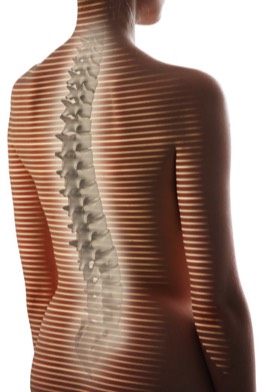

Wie funktioniert die 3D / 4D Messung?
Der Patient steht vor einer Aufnahmeeinrichtung, bestehend aus Videokamera und Projektor. Auf die Oberfläche des Rückens wird ein Lichtraster projiziert und dreidimensional reflektiert. Die Videokamera erfasst als Bildserie (4D) das dreidimensionale Muster. Das angeschlossene Computerprogramm ermittelt daraus schließlich die Form des gesamten Rückens, der Wirbelsäule und die Stellung des Beckens.Unsere Haltung und Körperstatik wird beeinflusst von vielerlei Faktoren u.a. Schuhwerk, Schuheinlagen, Bissfehler, Zahnschienen, Brillen.
Zu den faszinierenden Möglichkeiten dieses lichtoptischen Messverfahrens gehört es, diese Einflüsse deutlich darzustellen, Alternativen zu testen und Störfaktoren gezielt zu beseitigen.
In der Hand des osteopathischen Arztes schöpft die dreidimensionale Wirbelsäulenvermessung ihr ganzes Potential aus. Der Einfluss auf- und absteigender Funktionsketten im Organismus kann studiert werden, der Erfolg osteopathischer Korrekturen wird nicht nur fühlbar sondern auch messbar.
Für wen eignet sich die 3D-Wirbelsäulenvermessung?
Für wen eignet sich die 3D-Wirbelsäulenvermessung?
• für Erwachsene mit wiederkehrenden Wirbelsäulen- und Beckenbeschwerden- bei Beckenverdrehungen und Beinlängendifferenzen für die exakte Korrektur
- bei Wirbelsäulenverkrümmungen (Skoliose, Rundrücken) zur genauen Vermessung und strahlungsfreien Verlaufskontrolle
- bei Haltungsschwäche von Kindern, Jugendlichen und Erwachsenen
- zur Anpassung und Überprüfung von Schuheinlagen, Schuhwerk
- vor und nach Eingliedern neuer Bissflächen (Brücken, Kronen, Implantate) oder Kieferorthopädie zum Ausschluss eines Fehlbisses mit negativer Beeinflussung der Beckenachse.


How does the 3D / 4D measurement work?
The patient stands in front of a recording device, consisting of a video camera and projector. On the surface of the patient’s back a light grid is projected and reflected in three dimensions. The video camera records the three-dimensional pattern as an image series (4D). The connected computer program finally calculates the shape of the entire back, the position of the pelvis and the vertebral segments.Our posture and body statics is influenced by many factors, among others footwear, shoe inserts, malocclusions, dental splints, and eyeglasses.
Among the fascinating possibilities of this optical measurement method is to effectively image these influences, to test alternatives and to eliminate disruptive factors.
In the hands of the osteopathic physician three dimensional spinal surveying exploits its full potential. The influence of ascending and descending function chains in the organism can be studied. The success of osteopathic adjustments will not only be felt but also be measurable.
For whom is the 3D spine measurement?
For whom is the 3D spine measurement?
• for adults with recurrent spinal and pelvic discomfort- pelvis twists and leg length difference for accurate correction
- in spinal curvature (scoliosis, kyphosis) for precise measurement and radiation-free follow-up
- in postural weakness of children, adolescents and adults
- adapting and testing of shoe insoles, footwear
- before and after insertion of new bite surfaces (bridges, crowns, implants) or orthodontics to exclude a malocclusion with a negative influence on the pelvic axis.



